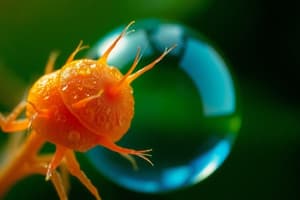Podcast
Questions and Answers
What is colour blindness and how does it affect the perception of red and green hues?
What is colour blindness and how does it affect the perception of red and green hues?
Colour blindness is a condition where one or more colour cone cells are not functioning properly, making red and green appear similar.
Explain the process of accommodation in the eye and its importance for focusing images on the retina.
Explain the process of accommodation in the eye and its importance for focusing images on the retina.
Accommodation is the adjustment of the lens shape by ciliary muscles to focus on objects at varying distances, ensuring the image is clearly projected onto the retina.
Describe hyperopia and the type of lens used to correct it.
Describe hyperopia and the type of lens used to correct it.
Hyperopia, or farsightedness, is when nearby objects appear blurry because light focuses behind the retina; it is corrected using a converging lens.
What is presbyopia and how does it relate to age?
What is presbyopia and how does it relate to age?
Explain myopia and the corrective measures typically employed.
Explain myopia and the corrective measures typically employed.
What is the formula for calculating the index of refraction and what do its variables represent?
What is the formula for calculating the index of refraction and what do its variables represent?
Describe how triboluminescence differs from bioluminescence.
Describe how triboluminescence differs from bioluminescence.
What are the characteristics of specular reflection and how does it differ from diffuse reflection?
What are the characteristics of specular reflection and how does it differ from diffuse reflection?
List the sources of light that utilize chemical processes and give one example for each.
List the sources of light that utilize chemical processes and give one example for each.
What are the two Laws of Reflection and why are they significant?
What are the two Laws of Reflection and why are they significant?
What is the function of the pupil in the eye?
What is the function of the pupil in the eye?
How do ciliary muscles contribute to vision?
How do ciliary muscles contribute to vision?
What are rods primarily responsible for in the human eye?
What are rods primarily responsible for in the human eye?
Describe the role of the retina in vision.
Describe the role of the retina in vision.
What is the role of the vitreous humor?
What is the role of the vitreous humor?
How do cones differ from rods in their function?
How do cones differ from rods in their function?
What is the optic nerve's function within the eye?
What is the optic nerve's function within the eye?
What protective role does the cornea play in the eye?
What protective role does the cornea play in the eye?
Would you expect light passing through glass to travel faster or slower than through ethyl alcohol?
Would you expect light passing through glass to travel faster or slower than through ethyl alcohol?
When light travels from water to glass, does it bend towards the normal or away from the normal?
When light travels from water to glass, does it bend towards the normal or away from the normal?
Calculate the index of refraction for a substance where the speed of light is $2.04 \times 10^8$ m/s. What is the substance's likely identification?
Calculate the index of refraction for a substance where the speed of light is $2.04 \times 10^8$ m/s. What is the substance's likely identification?
For a material with an index of refraction of 0.90, what is the speed of light in this material, and why would it be special?
For a material with an index of refraction of 0.90, what is the speed of light in this material, and why would it be special?
Is the second medium more or less optically dense than glass if an angle of incidence of 20.0° results in an angle of refraction of 25.0°? Will light travel faster or slower in the second medium?
Is the second medium more or less optically dense than glass if an angle of incidence of 20.0° results in an angle of refraction of 25.0°? Will light travel faster or slower in the second medium?
What are the components that need to be labeled on concave and convex mirror diagrams?
What are the components that need to be labeled on concave and convex mirror diagrams?
Describe the image characteristics for a concave mirror when the object is located between the center of curvature and the focus.
Describe the image characteristics for a concave mirror when the object is located between the center of curvature and the focus.
What does the 'A' in the SALT method represent, and how does it differ between concave and convex mirrors?
What does the 'A' in the SALT method represent, and how does it differ between concave and convex mirrors?
How does the location of a virtual image formed by a convex mirror compare to a real image in a concave mirror?
How does the location of a virtual image formed by a convex mirror compare to a real image in a concave mirror?
In the SALT method, what does the 'S' refer to, and how might it differ for a real image versus a virtual image?
In the SALT method, what does the 'S' refer to, and how might it differ for a real image versus a virtual image?
Explain the significance of the focus point (F) for concave mirrors in image formation.
Explain the significance of the focus point (F) for concave mirrors in image formation.
What is the purpose of the principal axis in the context of mirror diagrams?
What is the purpose of the principal axis in the context of mirror diagrams?
What type of image is formed by both concave and convex mirrors when the object is placed far away?
What type of image is formed by both concave and convex mirrors when the object is placed far away?
Flashcards
Refraction
Refraction
The bending of light as it passes from one medium to another.
Index of Refraction
Index of Refraction
The ratio of the speed of light in a vacuum to the speed of light in a medium.
Luminous Object
Luminous Object
Light emitted by a source, such as the sun or a light bulb.
Specular Reflection
Specular Reflection
Signup and view all the flashcards
Diffuse Reflection
Diffuse Reflection
Signup and view all the flashcards
Color Blindness
Color Blindness
Signup and view all the flashcards
Accommodation
Accommodation
Signup and view all the flashcards
Hyperopia (Farsightedness)
Hyperopia (Farsightedness)
Signup and view all the flashcards
Myopia (Nearsightedness)
Myopia (Nearsightedness)
Signup and view all the flashcards
Presbyopia
Presbyopia
Signup and view all the flashcards
Index of Refraction (n)
Index of Refraction (n)
Signup and view all the flashcards
Light Bending Away From the Normal
Light Bending Away From the Normal
Signup and view all the flashcards
Light Bending Towards the Normal
Light Bending Towards the Normal
Signup and view all the flashcards
Speed of Light and Index of Refraction
Speed of Light and Index of Refraction
Signup and view all the flashcards
What is the pupil?
What is the pupil?
Signup and view all the flashcards
What is the sclera?
What is the sclera?
Signup and view all the flashcards
What is the iris?
What is the iris?
Signup and view all the flashcards
What is the cornea?
What is the cornea?
Signup and view all the flashcards
What is the aqueous humor?
What is the aqueous humor?
Signup and view all the flashcards
What is the lens?
What is the lens?
Signup and view all the flashcards
What is the retina?
What is the retina?
Signup and view all the flashcards
What is the optic nerve?
What is the optic nerve?
Signup and view all the flashcards
Principal Axis
Principal Axis
Signup and view all the flashcards
Focus (F)
Focus (F)
Signup and view all the flashcards
Center of Curvature (C)
Center of Curvature (C)
Signup and view all the flashcards
Vertex (V)
Vertex (V)
Signup and view all the flashcards
Mirror Analysis
Mirror Analysis
Signup and view all the flashcards
SALT Method
SALT Method
Signup and view all the flashcards
Concave Mirror
Concave Mirror
Signup and view all the flashcards
Convex Mirror
Convex Mirror
Signup and view all the flashcards



